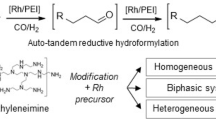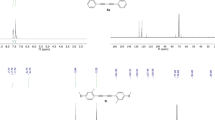Abstract
A new poly(ethylene glycol)-supported multiple hydrogen bond catalyst has been prepared and its ability as a promoter in asymmetric transfer hydrogenation of β-acylamino nitroolefins has been studied. The PEG-supported multiple hydrogen bond catalyst exhibits high enantioselective manner (ee up to 95%) and it is easily removable by selective precipitation with diethyl ether and filtration from the reaction mixture, the polymer-bound catalyst has been recycled up to six times no loss of chemical and stereochemical efficiency.
Graphical Abstract




Similar content being viewed by others
References
Blaser HU, Malan C, Pugin B et al (2003) Selective hydrogenation for fine chemicals: recent trends and new developments. Adv Synth Catal 345:103. https://doi.org/10.1002/adsc.200390000
Carpentier JF, Bette V (2002) Chemo- and enantioselective hydrosilylation of carbonyl and imino groups. An emphasis on non-traditional catalyst systems. Curr Org Chem 6:913. https://doi.org/10.2174/1385272023373851
Zhou M, Dong DJ, Zhu BL et al (2013) Rhodium-catalyzed enantioselective hydrogenation of β-acylamino nitroolefins: a new approach to chiral β-amino nitroalkanes. Org Lett 15:5524. https://doi.org/10.1021/ol4026843
Xie JH, Zhu SF, Zhou QL (2011) Transition metal-catalyzed enantioselective hydrogenation of enamines and imines. Chem Rev 111:1713. https://doi.org/10.1021/cr100218m
Schneider JF, Lauber MB, Muhr VJ et al (2011) Readily available hydrogen bond catalysts for the asymmetric transfer hydrogenation of nitroolefins. Org Biomol Chem 9:4323. https://doi.org/10.1039/C1OB05059A
Liu XW, Yan Y, Wang YQ et al (2012) Highly enantioselective reduction of β-amino nitroolefins with a simple N-sulfinyl urea as bifunctional catalyst. Chem Eur J 18:9204. https://doi.org/10.1002/chem.201201192
Artinelli E, Vicini AC, Mancinell M et al (2015) Catalytic highly enantioselective transfer hydrogenation of β-trifluoromethyl nitroalkenes. An easy and general entry to optically active β-trifluoromethyl amines. Chem Commun 51:658. https://doi.org/10.1039/C4CC07801B
Reger TS, Janda KD (2000) Polymer-supported (salen)Mn catalysts for asymmetric epoxidation: a comparison between soluble and insoluble matrices. J Am Chem Soc 122:6929. https://doi.org/10.1021/ja000692r
Wentworth P, Janda KD (1999) Liquid-phase chemistry: recent advances in soluble polymer-supported catalysts, reagents and synthesis. Chem Commun. https://doi.org/10.1039/A901955C
Long J, Gao WC, Guan YQ et al (2018) Nickel-catalyzed highly enantioselective hydrogenation of β-acetylamino vinylsulfones: access to chiral β-amido sulfones. Org Lett 20:5914. https://doi.org/10.1021/acs.orglett.8b02579
Wang BT, Zhang SG, Zhen B et al (2017) Synthesis of chloro-termination polyethylene glycol via reaction of polyethylene glycol and thionyl chloride. J Chem Eng Chin Univ 31:1389. https://doi.org/10.3969/j.issn.1003-9015.2017.06.018
Acknowledgements
This study was supported by the Chna’s Hebei Province Science and Technology Support (No. 18271404D).
Author information
Authors and Affiliations
Corresponding author
Ethics declarations
Conflict of interest
The authors declare that they have no conflict of interest.
Additional information
Publisher's Note
Springer Nature remains neutral with regard to jurisdictional claims in published maps and institutional affiliations.
Rights and permissions
About this article
Cite this article
Zhang, B., Shi, L. A Poly(ethylene glycol)-Supported Multiple Hydrogen Bond Catalyst for the Asymmetric Transfer Hydrogenation of β-Acylamino Nitroolefins. Catal Lett 149, 2836–2843 (2019). https://doi.org/10.1007/s10562-019-02755-1
Received:
Accepted:
Published:
Issue Date:
DOI: https://doi.org/10.1007/s10562-019-02755-1




